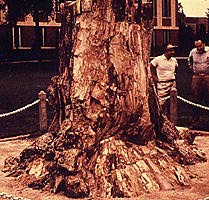

At right is a fossilized stump of Archaeopteris, on the OSU campus. Compare with the people in the background for scale; you can click on the picture for an enlargement.
Two major groups of progymnosperms are recognized, the Archaeopteridales and Aneurophytales. A third group, the Protopityales is sometimes recognized, but it is poorly known, and so its relationship to other plants is unclear.
In the case of Archaeopteris, the leaves were reminiscent of ferns, and in fact produced and released spores in a manner consistent with this interpretation. As a result, they were considered to be some sort of fossil fern. The wood Callixylon, by contrast, was considered similar to modern conifers, and was placed with the seed plants. When Dr. Beck demonstrated that fossils of Archaeopteris were physically attached to Callixylon wood, it was realised that the plant, now collectively called Archaeopteris, was actually an extinct group of plants unlike any living plants today -- it had both wood and fern-like reproduction.
The xylem of progymnosperms, however, had circular-bordered pits, which are similar, but not identical, to those of conifers. Therefore, some paleobotanists have reconsidered the proposed close relationship between conifers and the progymnosperms.
Archaeopteris is common in Devonian strata throughout the northern hemisphere, and has been reported from Australia. It has been reconstructed as a large conifer-like tree, much like a redwood or arbor-vitae, and is believed to have reached heights of up to 20 meters. Other genera in this group are less well known, though one exciting possibility is that the small plant Eddya might actually be a seedling of Archaeopteris.
The most common member of the Aneurophytales, Aneurophyton, is found in rocks of Middle and Upper Devonian age. This plant resembles some trimerophytes, such as Pertica, in that it has three-dimensional branching with branches arranged in a spiral or decussate pattern. Like the trimerophytes, Aneurophyton had a protostele, which was commonly lobed. However, the aneurophytes added wood to their stem and may have grown into bush-sized plants or extensive vines. In this way, they are intermediate between the smaller, usually herbaceous trimerophytes and the larger tree-sized progymnosperms like Archaeopteris.
Like other progymnosperms, aneurophytes dispersed by spores. Sporangia were clustered on fertile parts of branches away from the leaves. Most of the aneurophytes were homosporous, but one genus, Tetraxylopteris produced spores with an unusually large range of sizes. This plant may have been on its way to evolving heterospory.
The progymnosperms have been long considered important players in the evolution of seeds. Many paleobotanists believe that the earliest seed plants evolved from heterosporous Middle Devonian plants like the progymnosperms. Since the "seed habit" begins with the reduction to a single functional megaspore in each megasporangium, heterospory seems like a logical intermediate step. This would point toward Archaeopteris and its kin as the ancestors of seed plants. However, some paleobotanists argue that a heterosporous intermediate may not have been necessary. In this case, the aneurophytes may also be considered candidates for seed-plant ancestors.


